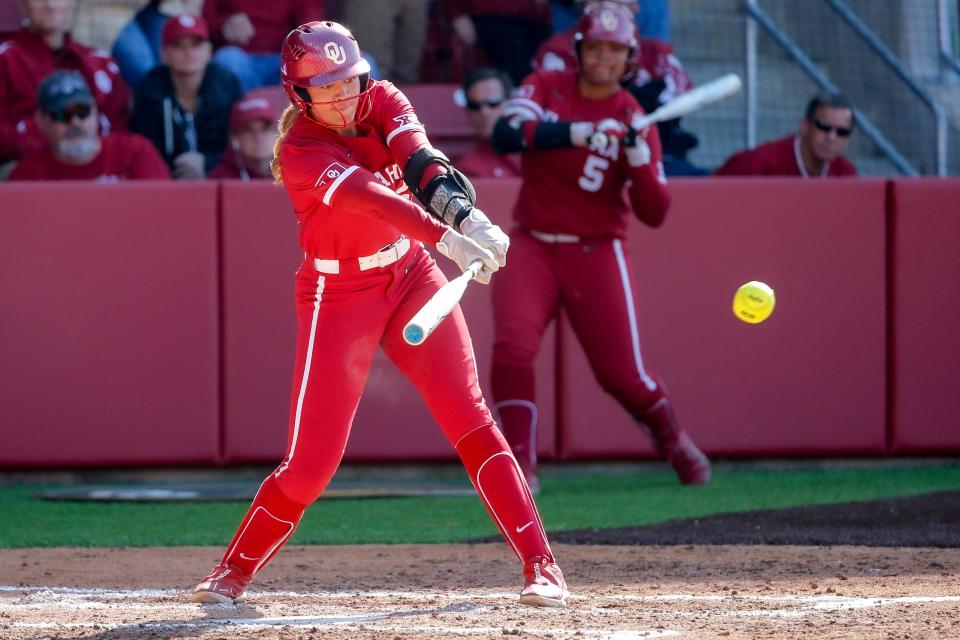Why are softballs yellow? Color, size explained for 2024 NCAA Softball Tournament, WCWS
Scoring has been up in college softball over the last few seasons, and this year's postseason with the NCAA Softball Tournament and Women's College World Series should be no different.
In last year's Women's College World Series alone — in which Oklahoma won its third consecutive national championship title — 79 total runs were scored in 14 games, three of which ended in the run-ahead rule. Some of the top projected teams in this year's postseason tournament — including No. 1 seed Texas, No. 2 seed Oklahoma and No. 4 seed Florida, — hold spots in the top 10 best offenses in the country in runs scored this season.
REQUIRED READING: Can anyone stop OU softball early in NCAA Tournament? Meet Norman Regional opponents
As the 2024 NCAA Softball Tournament begins and progresses through the WCWS, fans who watch the action unfold undoubtedly will notice one key element as a team's hitters look to hit their way to Oklahoma City: The size — and color — of the softballs they hit.
Here's what you need to know about the makeup of a softball:
Why are softballs yellow?

You guessed it: It has to do with visibility. Indeed, the specific color of a standard NCAA softball is optic yellow (with an RGB of 223,255,79).
It wasn't until 2002 that the NCAA and the National Association of Intercollegiate Athletics (NAIA) instituted the rule that the color of a softball would be the optic yellow it is today. The reason behind this change was that since the pitchers' mound on a softball diamond is closer to home plate than it is on a baseball diamond — 43 feet in softball as opposed to 60 in baseball — it would be easier for a hitter to pick up a yellow colored ball as it reaches the batter's box, as compared to a white colored ball.
REQUIRED READING: NCAA Softball Tournament committee 'constantly' had Texas over OU as No. 1 seed
The softball itself was also hardened inside for a little bit more of a livelier ball — i.e., more offense.
Though the NCAA and NAIA standardized softballs in 2002, that wasn't the first year optic yellow softballs were used in the sport. As noted in a 1993 report by The Seattle Times, the Pac-10 started using the yellow softballs with an elevated red seam sown into them starting in 1993 to "put more hitting in the game."
Before 1993, softballs were colored white, like a baseball.
How big are college softballs?
Like many things involving softball and baseball, both have different-sized balls: A softball is roughly 3 inches bigger in circumference compared to a baseball. Indeed, a standard NCAA baseball has a circumfrence between 9 and 9 1/2 inches, whereas a softball is measured anywhere between 11 7/8 inches and 12 1/4 inches.
Here are the official requirements of a regulation softball, as noted in Rule 3.2.1 of the NCAA's softball rulebook:
"The ball shall be an optic yellow sphere with raised red thread seams. It shall have a polycore center. The cover shall be smooth and made of chrometanned, top-grain horsehide or cowhide. It shall be affixed to the core by cement and sewn with waxed cotton or linen thread by the two-needle method with not fewer than 88 stitches per cover. The ball shall meet the following specifications."
Minimum circumference: 11 7/8 inches
Maximum circumference: 12 1/4 inches
Minimum weight: 6 1/2 ounces
Maximum weight: 7 ounces
Maximum COR (coefficient of restitution): 47
Compression: Minimum 275 pounds; maximum 375 pounds
Maximum dynamic stiffness: 7,500 pounds per square inch.
The slightly heavier softball — which weighs between 1.7 and 2.3 ounces more than a baseball — also can add some strategy to the game, including placing it at different spots of the batter's box during an at-bat since they are pitching underhand compared to overhand.
This article originally appeared on Oklahoman: Why are softballs yellow? Color, size explained for 2024 NCAA Softball Tournament, WCWS


